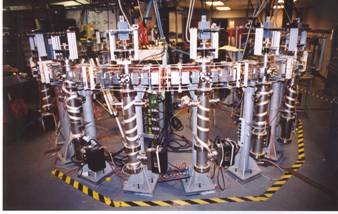Extreme Beams
By: Patrick O'Shea
The landscape of physics over the past fifty years has been dominated by giant particle accelerators for use in high energy and nuclear physics, and more recently as light sources. The fundamental physics of beams as complex swarms of interacting charged particles has often been smothered by the engineering of the accelerators. Since the earliest days, accelerator technology has been driven by an ever escalating quest for higher energies, as exemplified by the famous Livingston plot that shows the energy of the most advanced accelerators increasing by an order-of-magnitude per decade. In recent years, however, the attention has shifted more toward quality and brightness in beams, and, therefore, to a focus on the physics of the particle dynamics in the beam. The Maryland Charged Particle Beam Group has long been a leader in the exploration of beam itself as a complex dynamical system. Our research program is characterized by a close collaboration between theory, simulation and experiment.
 |
|
The University of Maryland Electron Ring |
A Space Charge Odyssey
The performance of electron and ion accelerators depends critically on the quality of the beams they produce. This is true for many applications in high-energy and nuclear physics, materials science nanotechnology and biomedicine (e.g., spallation neutron sources and x-ray free-electron lasers). As we strive to produce evermore intense beams, nonlinear dynamics play an increasingly important role in the evolution of particle distributions and resultant beam quality. At very low intensity, the beam distribution is largely determined by the external accelerating and focusing forces and is independent of the details of the particle distribution. At very high intensity, however, the self-electromagnetic fields of the beam play a dominant role in beam evolution, and these self fields are very much dependent on the particle distribution. To study intense beam phenomena we have developed the University of Maryland Electron Ring (UMER). UMER is a compact model (4-m diameter) of a large recirculating accelerator. Even though it operates at only 10 kilovolts, UMER is capable of reaching beam intensities far beyond those of other accelerators. UMER is ideally suited for student projects. UMER’s electron current of 100 milliamps is exceedingly large for such a low energy. When scaled to energies and parameters comparable to higher energy accelerators, the UMER beam possesses orders of magnitude more space charge than other existing machines. The beam in UMER is truly and extreme beam. UMER’s beam intensity, and quality of its beam diagnostics and simulation support place our lab at the forefront of exploring space charge dynamics. In addition to the above mention applications, we are also exploring the use the of charged particle beams as a model system for the study of galactic dynamics.
Free-Electron Lasers
The exploration of technologies for free-electron light sources is an important aspect of our work Starting with the discovery controlled fire, humans have learned to use light to see, to communicate, and to initiate chemical reactions (e.g. cooking). We now use light in many forms such as x-ray, visible laser light, microwaves and radio waves. There are still some regions of the spectrum we here better and more powerful sources of light are needed, such as the x-ray, infrared and far-infrared (Terahertz). Better sources will be useful for application as diverse as improved biological imaging to naval defense, for example. Free-Electron Lasers (FELs) are a type of laser that is suited to producing high power light at wavelengths where other sources are weak. FELs use electron beams passing through a magnet array to produce light. As with other accelerator applications, the quality of the FEL light output depends critically on the quality of the electron beam used to drive the FEL. We are exploring new technologies to create, measure and control bright, high quality, electron beams. In recent years we have invented new types of electron sources, and new means to measure and control electron swarms. We perform experiments at UMER, and our Photocathode Lab as well as at Brookhaven National Lab in New York, Argonne National Lab near Chicago, and Thomas Jefferson National Accelerator Facility in Virginia.
Our labs are housed in the Institute for Research in Electronics and Applied Physics, and out research supported by the US Department of Energy, the Office of Naval Research and the Joint technology Office.
--------------------------------------------------------------------------------------------------------------------------------------------------------------------------------------------
Patrick O'Shea is Professor and Chair of the Department of Electrical & Computer Engineering, with affiliate appointments in the Department of Physics, the Institute for Research in Electronics & Applied Physics, and in the Maryland Nano Center.

